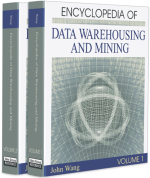Добрый день, Коллеги. Важное сообщение, просьба принять участие. Музей Ферсмана ищет помощь для реставрационных работ в помещении. Подробности по ссылке
Encyclopedia of data warehousing and mining / Энциклопедия хранилищ данных и интеллектуального анализа данных
There are two aspects of interestingness of rules that have been studied in data mining literature, objective and subjective measures (Liu, 1997; Adomavicius & Tuzhilin, 1997; Silberschatz & Tuzhilin, 1995, 1996). Objective measures are data-driven and domain-independent. Generally, they evaluate the rules based on their quality and similarity between them. Subjective measures, including unexpectedness, novelty and actionability, are user-driven and domain-dependent. A rule is actionable if user can do an action to his/her advantage based on this rule (Liu, 1997). This definition, in spite of its importance, is too vague and it leaves open door to a number of different interpretations of actionability. In order to narrow it down, a new class of rules (called action rules) constructed from certain pairs of association rules, has been proposed in Ras & Wieczorkowska (2000). A formal definition of an action rule was independently proposed in Geffner & Wainer (1998). These rules have been investigated further in Tsay & Ras (2004) and Tzacheva & Ras (2004). To give an example justifying the need of action rules, let us assume that a number of customers have closed their accounts at one of the banks. We construct, possibly the simplest, description of that group of people and next search for a new description, similar to the one we have, with a goal to identify a new group of customers from which no one left that bank. If these descriptions have a form of rules, then they can be seen as actionable rules. Now, by comparing these two descriptions, we may find the cause why these accounts have been closed and formulate an action, which if undertaken by the bank, may prevent other customers from closing their accounts. Such actions are stimulated by action rules and they are seen as precise hints for actionability of rules. For example, an action rule may say that by inviting people from a certain group of customers for a glass of wine by the bank, it is guaranteed that these customers will not close their accounts and they do not move toanother bank. Sending invitations by regular mail to all these customers or inviting them personally by giving them a call are examples of an action associated with that action rule. <...>




